
Original Link: https://www.anandtech.com/show/2773
The Lynnfield Preview: Rumblings of Revenge
by Anand Lal Shimpi on May 29, 2009 1:00 PM EST- Posted in
- CPUs
Note: This article was not condoned or supported in any way by Intel. We obtained all pre-release hardware on our own. Enjoy.
The Recap
Yeech, ok, this is more complicated than it should be. Last year Intel launched its brand new Nehalem architecture, the first processor was codenamed Bloomfield and sold as the Core i7.

Nehalem - Bloomfield, aka Core i7
The Core i7 has four cores (with Hyper Threading, so that’s 8 threads), an 8MB L3 cache and a triple-channel DDR3 memory controller. Of course there’s a lot of other special sauce that makes the i7 the beast that it is; if you want more details check out my original Nehalem architecture article.
Since its launch, i7 has only been available in three flavors: the 920, 940 and 965. The most affordable one, the i7-920, costs $284 in 1Ku quantities.
| Processor | Clock Speed | Cores / Threads | Maximum Single Core Turbo Frequency | TDP | Price |
| Intel Core i7-965 Extreme | 3.20GHz | 4 / 8 | 3.46GHz | 130W | $999 |
| Intel Core i7-940 | 2.93GHz | 4 / 8 | 3.20GHz | 130W | $562 |
| Intel Core i7-920 | 2.66GHz | 4 / 8 | 2.93GHz | 130W | $284 |
The Core i7 fits into Intel’s new LGA-1366 socket and is mated with Intel’s X58 chipset:
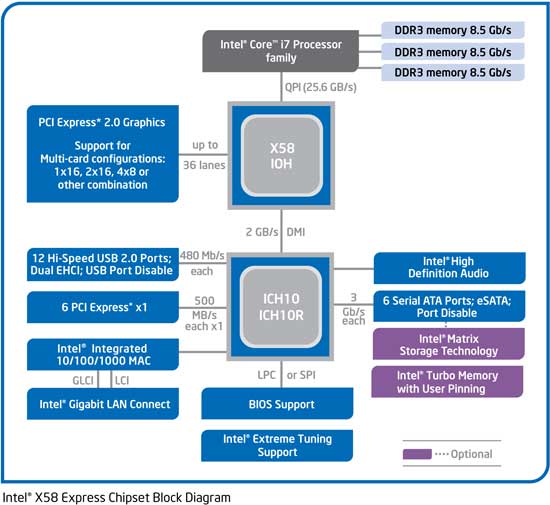
With the memory controller on-die, the X58 chipset acts like a PCIe switch than anything else; all other I/O (e.g. USB, SATA, Ethernet, etc...) go through the ICH10 which is connected to the X58 hub.
Despite being a relatively simple piece of silicon, Intel prices the X58 chipset as a premium product. The X58 chipset is more expensive than any other desktop Intel chipset on the market, that includes P45 and X48. In turn, X58 motherboards are pricey.
At launch X58 motherboards sold for well above $200 and it took a while for us to see boards finally drop down to and below that $200 price point. Only recently have we found a motherboard that’s even somewhat affordable with MSI’s X58M priced at $169.
With a $200 motherboard and a $284 CPU, the i7 was priced out of competing with even AMD’s highest end Phenom II. While the Phenom II X4 955 costs $245, you can easily pair it with a $100 motherboard.
Rather than drive LGA-1366 pricing down, Intel had another plan - to introduce a more mainstream platform for Nehalem.
Making Nehalem Affordable: LGA-1156
Take the Core i7, shave off one memory controller and replace the high bandwidth QPI link with Intel’s slower DMI and you’ve got the makings of a (more) mainstream Nehalem.
Many have been calling this processor the Core i5 although I’m not quite ready to jump on that bandwagon, so I’ll keep referring to it by its socket (LGA-1156) or codename (Lynnfield).
Intel’s QPI is a very fast bus delivering up to 25.6GB/s of bandwidth. The image below shows you how Intel sees it being useful:
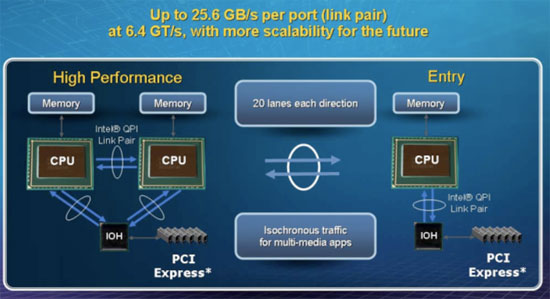
If you’ve got a multi-socket system (e.g. dual processor Xeon workstation, or Skulltrail successor) or if you’ve got a lot of high bandwidth PCIe devices (e.g. multi-GPU or lots of Larrabees) then QPI makes a whole lot of sense. However, if you’ve got a single socket system and aren’t running a lot of high bandwidth PCIe devices then QPI is overkill.
Intel’s DMI is the link used between the X58 chipset and the ICH10 I/O controller, it’s a much more conservative bus capable of delivering 2 - 4GB/s of bandwidth. That’s enough bandwidth for things like SATA and USB but a single PCIe x16 slot can deliver 16GB/s of bandwidth, far too much for Intel’s DMI.
Instead of crippling graphics on its mainstream platform, Intel did the next best thing and integrated 16 PCIe 2.0 lanes onto the die of its mainstream Nehalem part.
What you get looks like this:
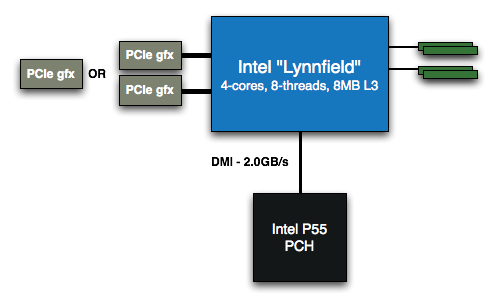
A Lynnfield system only need two chips (CPU + PCH) while a Bloomfield system needs three (CPU + IOH + ICH)
The 16 PCIe 2.0 lanes can be configured as one x16 or two x8, allowing you enough bandwidth and very low latency to do things like CrossFire or SLI. Any additional PCIe lanes will branch off of what Intel is now calling the Platform Controller Hub (PCH). The first PCH is Intel’s P55 chipset; all you need is a Lynnfield CPU and the P55 PCH, no additional ICH is necessary as all of that functionality is embedded in the PCH.
The price of Intel’s P55 PCH is also much lower than the X58 chipset, in fact P55 is expected to be price competitive with P45 + ICH10. In other words, we should eventually see P55 boards priced at $100 or less.
Getting rid of QPI and one of the three DDR3 channels knocked down the pin-count of LGA-1366, but adding in 16 PCIe 2.0 lanes brought it back up to 1156 which you can count in the socket below:
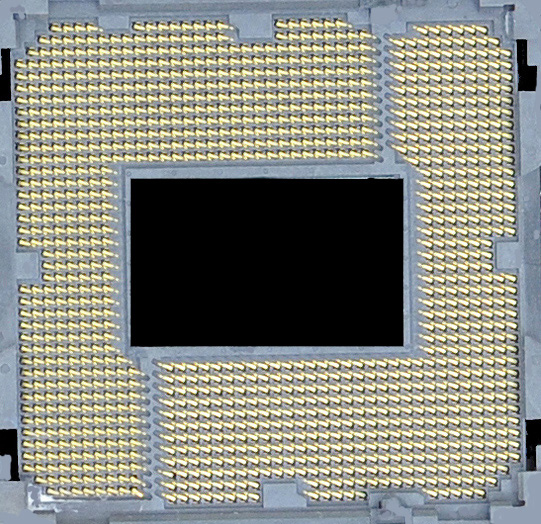
I’ve blacked out the motherboard around it and the caps in the middle to protect the innocent.
Lynnfield Pricing and Specs
From Intel’s first disclosure of Nehalem we knew that the architecture, albeit optimized for quad-core processors, would scale up to 8 cores and down to 2:

Lynnfield, however, does not scale Nehalem’s core count in any direction. The eight-core derivative is Nehalem-EX and the two-core versions will appear later this year in 32nm mobile form. Lynnfield is a direct replacement for the quad-core Penryn CPUs that have dominated the market for the past year and a half.
| Name | Manufacturing Process | Cores | Target Market | Release |
| Gulftown | 32nm | 6 | High End Desktop | 1H 2010 |
| Core i7 (Bloomfield) | 45nm | 4 | High End Desktop | Q4 2008 |
| Lynnfield | 45nm | 4 | Performance Desktop | Q3 2009 |
| Clarksfield | 45nm | 4 | High End Mobile | Q3 2009 |
| Clarkdale | 32nm | 2 | Mainstream Desktop | Q4 2009 |
| Arrandale | 32nm | 2 | Mobile | Q4 2009 |
A few places have published rumored Intel roadmaps for Lynnfield, indicating that three Lynnfield chips will be launched in the second half of this year:
| Model Number | Clock Speed | Cores / Threads | Maximum Single Core Turbo Frequency | TDP | Price |
| ? | 2.93GHz | 4 / 8 | 3.60GHz | 95W | $562 |
| ? | 2.80GHz | 4 / 8 | 3.46GHz | 95W | $284 |
| ? | 2.66GHz | 4 / 4 | 3.20GHz | 95W | $196 |
All of the processors are quad-core Nehalems with the same cache sizes as the Core i7. The only crippled beast is the entry level Lynnfield that has Hyper Threading disabled. Note the ridiculously high turbo frequencies which are, I believe, Lynnfield’s secret weapon.
| Processor | Price |
| Intel Core i7-940 (2.93GHz) | $562 |
| Intel Lynnfield 2.93GHz | $562 |
| Intel Core i7-920 (2.66GHz) | $284 |
| Intel Lynnfield 2.80GHz | $284 |
| Intel Lynnfield 2.66GHz | $196 |
| Intel Core 2 Quad Q9650 (3.00GHz) | $316 |
| Intel Core 2 Quad Q9550 (2.83GHz) | $266 |
| Intel Core 2 Quad Q9400 (2.66GHz) | $213 |
| Intel Core 2 Quad Q8400 (2.66GHz) | $183 |
| Intel Core 2 Quad Q8200 (2.33GHz) | $163 |
With a 2.66GHz Lynnfield and a $100 P55 motherboard you now have the ability to deliver a good quad-core system at around $150 - $200 cheaper than the cheapest Core i7. Price-wise the 2.66GHz Lynnfield would be priced cheaper than today's Core 2 Quad Q9400, and as you'll see Lynnfield is clearly a faster bet.
The 2.80GHz Lynnfield should also be able to outperform the i7-920 without a problem, at a lower total system cost as well.
Lynnfield’s Secret? Turbo Mode
The current Core i7 runs at a multiple of its BCLK, which is 133MHz. The Core i7-920 runs at 20x BCLK (2.66GHz) while the i7-965 runs at 24x BCLK (3.2GHz). If the chip isn’t running anywhere near its max TDP, the i7 will overclock itself by one speed bin (133MHz). Now say you’re running a single-threaded application that’s got only one core active, if the chip is cool enough the i7 will overclock itself by two speed bins (266MHz).
Turbo mode on the i7 works well and as I found is generally responsible for a 3 - 4% increase in performance. Despite its benefits, the i7’s Turbo mode is very conservative. Our own overclocking tests show that i7s have no problems running at up to 3.8GHz without any additional cooling or voltage, even with all four cores under full load. Given that it was Intel’s first Nehalem architecture, I can understand the hesitation not to go crazy with turbo.
The second version of Intel’s Nehalem turbo mode came with the high end Nehalem Xeon processors. While the single-socket processors worked just like the desktop i7s, the higher end dual-socket Xeons can turbo up more aggressively.
The Xeon E5520, E5530 and E5540 can all boost their clocks by one bin if 3 or 4 cores are active, but two bins if 1 or 2 are active. The X5000 series gets even more aggressive; with 3 or 4 cores active the chips can overclock themselves by up to 266MHz, and if 1 or 2 cores are active they can turbo up an additional 400MHz.
Lynnfield marks Intel’s third generation Nehalem turbo and is correspondingly more awesome.
The leaked roadmaps show that the two higher end Lynnfields can turbo up to five bins, or 667MHz while the entry level Lynnfield can turbo up to four bins (533MHz). I’m guessing this is for a single active core, but what about when more than one core is active? The table below has the turbo specs for the Xeon X5570 (95W TDP), the Core i7-940 (130W TDP) and my guesstimates for the 2.93GHz Lynnfield (95W TDP):
| Processor | Clock Speed | Max Turbo | |||
| 4 Cores Active | 3 Cores Active | 2 Cores Active | 1 Core Active | ||
| Intel Xeon X5570 | 2.93GHz | 3.2GHz | 3.2GHz | 3.33GHz | 3.33GHz |
| Intel Core i7-940 | 2.93GHz | 3.06GHz | 3.06GHz | 3.06GHz | 3.2GHz |
| Intel Lynnfield ESTIMATE | 2.93GHz | 3.2GHz | 3.2GHz | 3.60GHz | 3.60GHz |
Given the similarity in clock speed and TDP to Intel's Xeon X5570, I'm guessing the 2.93GHz Lynnfield will follow the same 2/2/3/3 turbo pattern as the Xeon. The higher max turbo frequency means that we'll at least see 3.60GHz with only 1 core active and I'm not really sure what will happen if two cores are active; if Intel follows the Xeon pattern then we'll see 3.6GHz as well, but we may very well see 3.33GHz or 3.46GHz instead when only two cores are active.
Either way a quad-core Lynnfield, thanks to its aggressive turbo mode, will end up delivering good performance regardless of the number of concurrent threads. Forget about it being a quad-core CPU and just think of it as a CPU that will perform as best as possible given its 95W thermal envelope. This, my friends, is the future of multi-core processors. It doesn't matter how many cores you have, just view them as execution resources; if you only need two powerful cores, that's what you get, and if you need to run 8 threads then that's what you'll get. Imagine what we'll get on the 4th or 5th generation of turbo modes.
To those who are wondering why Lynnfield even makes sense, I believe its turbo mode will be its saving grace. I'm more puzzled by the i7-920 at this point.
The LGA-1156 Socket and New Heatsinks
The LGA-1156 socket, as its abbreviated name implies, is designed to interface with Land Grid Array packaged CPUs. The pins are located in the socket itself. To install you set the CPU in the socket, lower a clamp and then fasten the clamp in place with a lever.
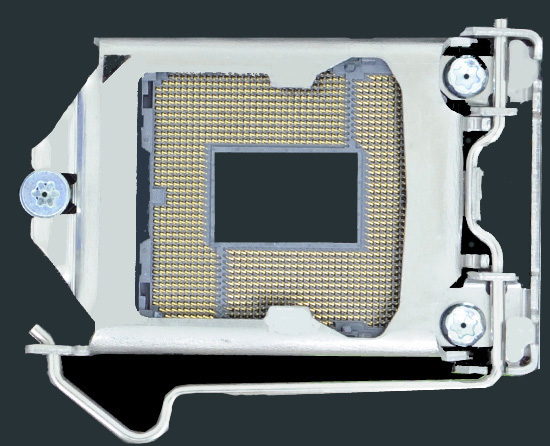
The LGA-1156 Socket
I wish I could provide a more detailed motherboard pic but a quick Google search should yield good results. The entire plate that holds the CPU in place actually lifts up and to the right in the picture above. The notch at the left of the plate slides under the screw you see on the left side and the lever at the bottom secures it in place. It works pretty well in person.
The new socket requires a new cooler. The four mounting holes are closer together on the LGA-1156 socket than they are on LGA-1366 boards, but further apart than LGA-775. It’s just different enough to require a brand new cooler, or at least a new mounting bracket.
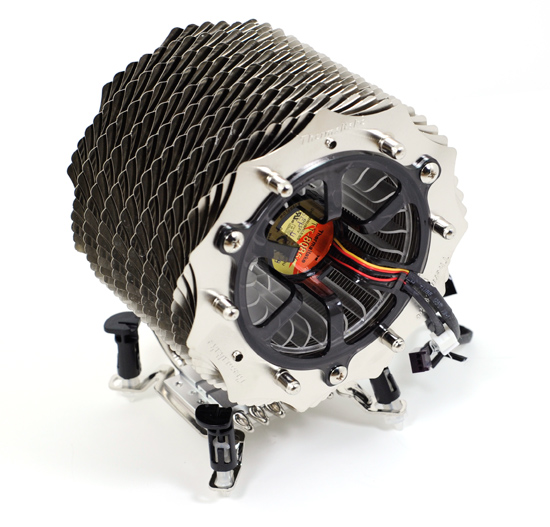
Thermaltake's SpinQ: Our first LGA-1156 cooler
Thermaltake sent over its SpinQ which will ship with an adjustable LGA-1366 bracket that can be used on both LGA-1156 and LGA-1366 motherboards. Each peg can slide back and forth to get the right positioning before locking it down, allowing the cooler to work on both platforms.
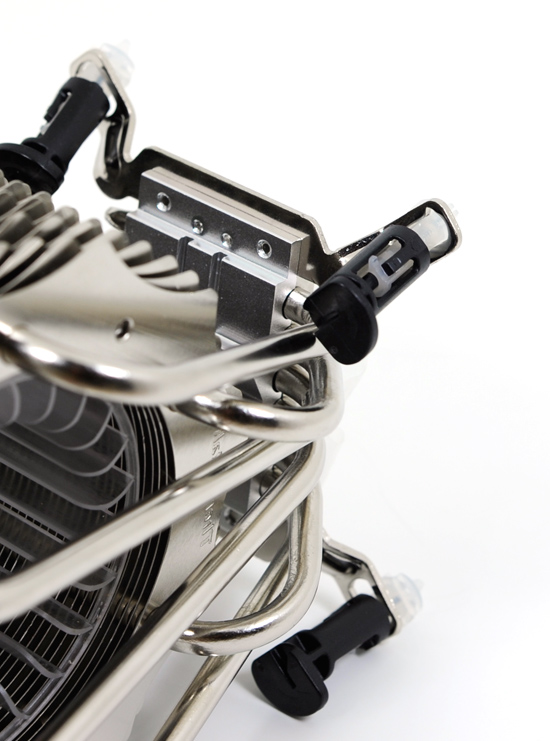
Oooh, adjustable mounting pegs
The cooler performed just fine in our tests and looks painful so try not to sit on it.
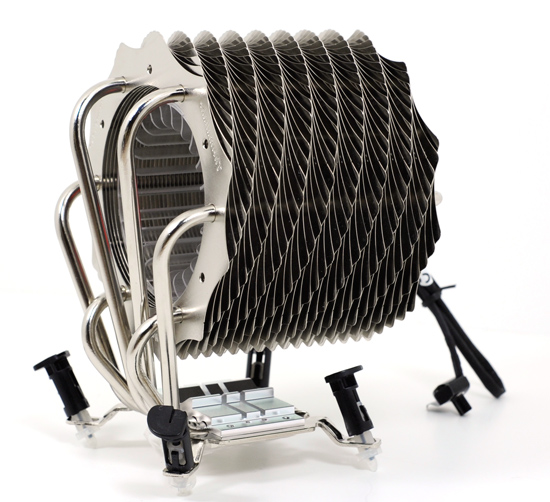
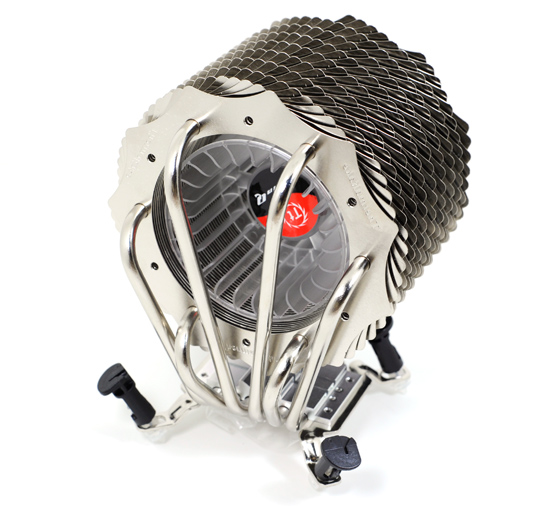
The First Lynnfield Sample
Let me preface this with the usual disclaimer. Intel did *not* supply me with this chip and it is most definitely pre-production silicon, not necessarily indicative of final, shipping performance.
With that out of the way, here is Lynnfield:

Lynnfield (front) vs. Bloomfield (back)
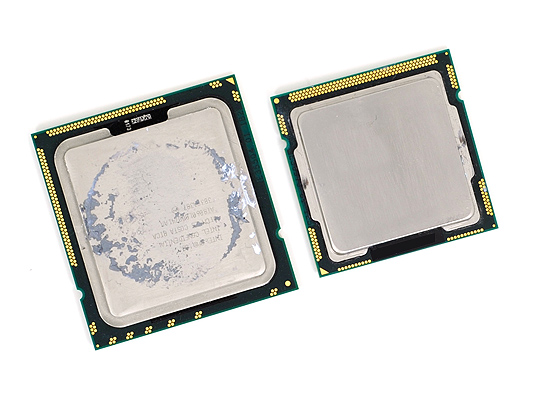
Core i7-Bloomfield (left) vs. Lynnfield (right)
It’s a lot smaller than the LGA-1366 Core i7, but compared to current Core 2 Quads it’s actually similar in size:
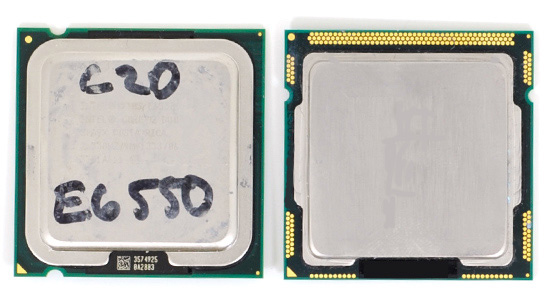
LGA-775 Core 2 Duo (left) vs. LGA-1156 Lynnfield (right)
Flipping the chips over you see that Lynnfield has a much higher pad density, enabling Intel to fit 1156 pads in about the same space as it fit 775 pads just a few years prior.
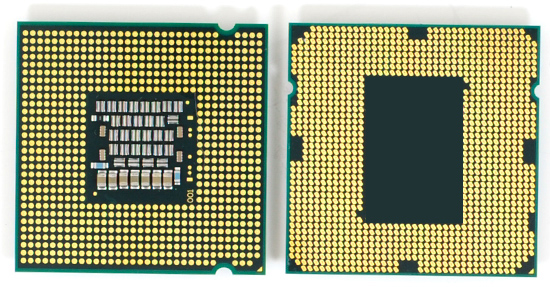
Core 2 (left) vs. Lynnfield (right)
Once more, I’ve blanked out all of the caps and other markings on the chip to protect the innocent.
The initial Lynnfield samples were all clocked at 2.13GHz with HT enabled. Turbo mode was also enabled but it too was a meager 2.26GHz regardless of how many cores were active. All of this was to enable motherboard manufacturers to test compatibility and performance of their P55 without giving away Lynnfield’s true performance.
Unfortunately this is the sample I tested with. Thankfully it was healthy enough for me to overclock the BLCK to 166MHz, resulting in a 2.66GHz frequency. Turbo mode was still stuck at a 1x increase over the stock frequency, so final Lynnfield performance should be much better in single and dual threaded apps than what you’ll see here today.
The results on the coming pages show three configurations. Lynnfield running at 2.13GHz with HT enabled, 2.66GHz with HT enabled and 2.66GHz with HT disabled. The latter is going to be the closest to actual Lynnfield performance (albeit still far away thanks the sample’s crippled turbo mode), the 2.66GHz with HT enabled just shows how much we gain from HT and the 2.13GHz chip is an experiment in seeing how low Intel could drop these things and still have a competitive part.
If you thought Nehalem needed Hyper Threading to be a strong performer, you were dead wrong.
Comments About Lynnfield's Readiness
The current rumors in the press are that Lynnfield is being held back in order to clear out excess Core 2 Quad inventory before it ships, because once this thing ships no one is going to want a Penryn anymore. Based on what I've seen, Lynnfield isn't ready just yet - it's not an artificial delay.
The motherboards are in rough shape, CF/SLI isn't working and we're still at very early revs of the CPU's silicon. While I think that the chip will be ready far in advance of its rumored September shipdate, the CPU and motherboards aren't yet.
The Test
Once more: the CPU we've tested here is pre-production silicon without all of its turbo modes enabled. I expect final, shipping performance to be higher in some cases.
| Motherboard: | Pre-release P55 Motherboard (Intel P55) Intel DX58SO (Intel X58) Gigabyte GA-MA790FX-UD5P (AMD 790FX) |
| Chipset: | Intel P55 |
| Chipset Drivers: | Intel 9.1.1.1012 (Intel) AMD Catalyst 8.12 |
| Hard Disk: | Intel X25-M SSD (80GB) |
| Memory: | Qimonda DDR3-1066 4 x 1GB (7-7-7-20) Corsair DDR3-1333 2 x 2GB (7-7-7-20) |
| Video Card: | eVGA GeForce GTX 280 |
| Video Drivers: | NVIDIA ForceWare 180.43 (Vista64) NVIDIA ForceWare 178.24 (Vista32) |
| Desktop Resolution: | 1920 x 1200 |
| OS: | Windows Vista Ultimate 32-bit (for SYSMark) Windows Vista Ultimate 64-bit |
SYSMark 2007 Performance
Our journey starts with SYSMark 2007, the only all-encompassing performance suite in our review today. The idea here is simple: one benchmark to indicate the overall performance of your machine.
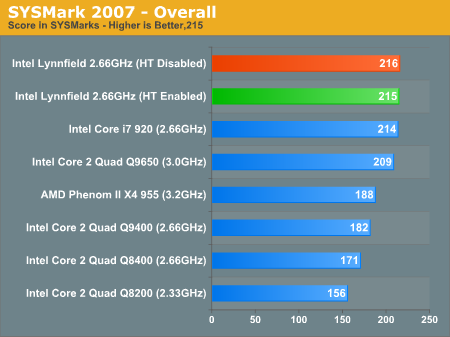
Ok. Right out of the gate, on pre-production silicon, with a pre-production motherboard and without a super aggressive turbo-mode the 2.66GHz Lynnfield sample is able to perform just as well as the i7-920. This is just as we expected given the minimal impact of triple-channel DDR3 on i7 that we pointed out in our original review.
Curiously enough, HT doesn't seem to do anything at all for Lynnfield in this test. Remember that stressing four cores is tough enough, finding eight CPU intensive threads is even more difficult.
Adobe Photoshop CS4 Performance
To measure performance under Photoshop CS4 we turn to the Retouch Artists’ Speed Test. The test does basic photo editing; there are a couple of color space conversions, many layer creations, color curve adjustment, image and canvas size adjustment, unsharp mask, and finally a gaussian blur performed on the entire image.
The whole process is timed and thanks to the use of Intel's X25-M SSD as our test bed hard drive, performance is far more predictable than back when we used to test on mechanical disks.
Time is reported in seconds and the lower numbers mean better performance. The test is multithreaded and can hit all four cores in a quad-core machine.

DivX 8.5.3 with Xmpeg 5.0.3
Our DivX test is the same DivX / XMpeg 5.03 test we've run for the past few years now, the 1080p source file is encoded using the unconstrained DivX profile, quality/performance is set balanced at 5 and enhanced multithreading is enabled:
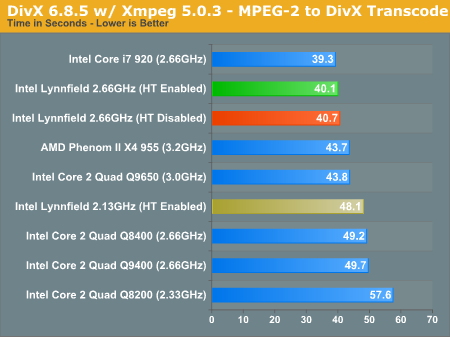
Once more, we see very little impact from Hyper Threading; the entry level Lynnfield may not be as bad as you'd think. On top of that, the crippled Lynnfield is less than 4% slower than the Core i7-920. Enable its aggressive turbo mode and I believe we'll have a chip that can actually beat, even if only slightly, the Core i7-920.
x264 HD Video Encoding Performance
Graysky's x264 HD test uses the publicly available x264 codec (open source alternative to H.264) to encode a 4Mbps 720p MPEG-2 source. The focus here is on quality rather than speed, thus the benchmark uses a 2-pass encode and reports the average frame rate in each pass.
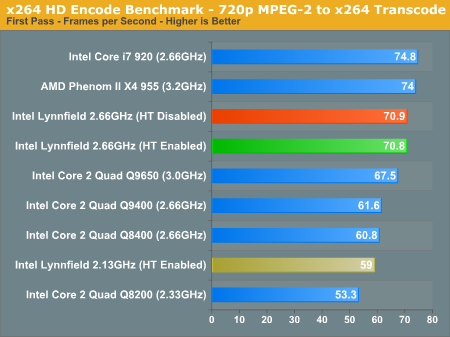
The x264 encode test shows one application where Hyper Threading is important. A 2.13GHz Lynnfield with HT enabled is faster than a 2.66GHz Lynnfield with HT disabled, unfortunately the former isn't on the roadmap and the latter is what we're getting.
Without HT enabled the $196 Lynnfield 2.66GHz core is faster than every non-EE Penryn Core 2 Quad as well as AMD's Phenom II X4 955 (in the second pass of the test). The i7-920 is significantly faster thanks to having HT enabled; and now we have the perfect reason for Intel disabling HT on the "low end" Lynnfield.
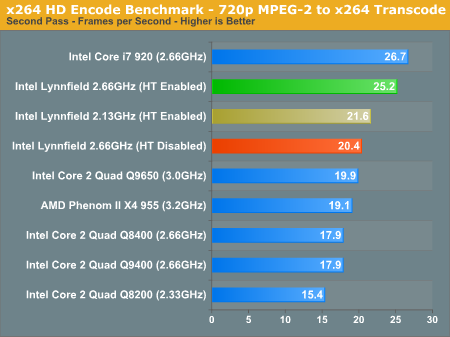
Windows Media Encoder 9 x64 Advanced Profile
In order to be codec agnostic we've got a Windows Media Encoder benchmark looking at the same sort of thing we've been doing in the DivX and x264 tests, but using WME instead.
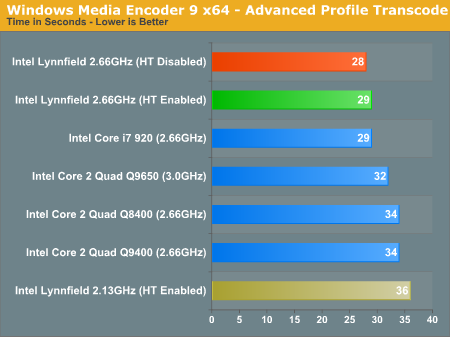
Tests that don't scale well with HT enabled, once again, show no performance difference between a 2.66GHz Lynnfield and a 2.66GHz Bloomfield.
3dsmax 9 - SPECapc 3dsmax CPU Rendering Test
Today's desktop processors are more than fast enough to do professional level 3D rendering at home. To look at performance under 3dsmax we ran the SPECapc 3dsmax 8 benchmark (only the CPU rendering tests) under 3dsmax 9 SP1. The results reported are the rendering composite scores:
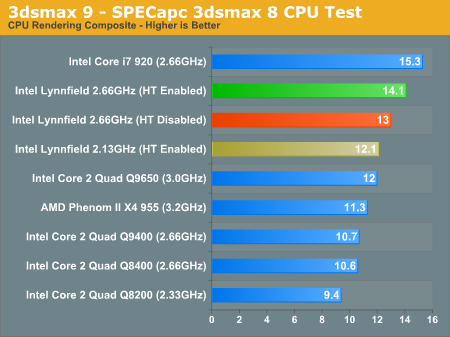
There are three key takeaway points here.
1) Hyper Threading allows the i7-920 to outperform the entry level Lynnfield by nearly 18%.
2) With HT disabled, the $196 Lynnfield is faster than the $316 Core 2 Quad Q9650. It's a true replacement for Penryn in the lineup.
3) Intel could release an even slower Lynnfield and, by enabling HT, offer a chip faster than all other Penryn and Phenom II based processors in the market.
Cinebench R10
Created by the Cinema 4D folks we have Cinebench, a popular 3D rendering benchmark that gives us both single and multi-threaded 3D rendering results.
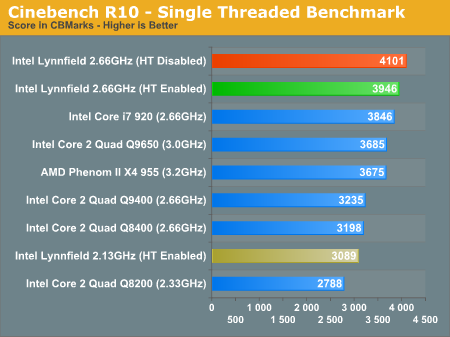
The single threaded Cinebench test shows us just how powerful the Nehalem core is. Remember, we're looking at single-core performance here.
Without an aggressive turbo mode, the 2.66GHz Lynnfield sample is faster than a 3.0GHz Penryn. Even at 2.13GHz Lynnfield is able to perform like a 2.5GHz Penryn. This is a very flexible core.
These results also give you an indication of exactly how strong the dual-core Nehalem derivatives will be in notebooks late this year and into 2010.
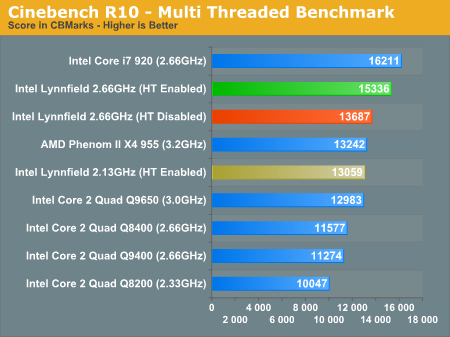
Crank up the thread count and feel the frustration brew. The entry level Lynnfield won't have Hyper Threading enabled, and thus it'll only outperform the Phenom II 955 by 3.4%. Had Intel enabled the HT switch, Lynnfield would not only be 16% faster than AMD's best but it would also be only 5% slower than the i7-920.
POV-Ray 3.73 beta 23 Ray Tracing Performance
POV-Ray is a popular, open-source raytracing application that also doubles as a great tool to measure CPU floating point performance.
I ran the SMP benchmark in beta 23 of POV-Ray 3.73. The numbers reported are the final score in pixels per second.
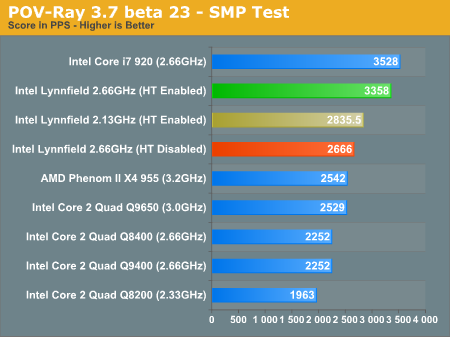
We see a similar story in POV-Ray.
Microsoft Excel 2007
Excel can be a very powerful mathematical tool. In this benchmark we're running a Monte Carlo simulation on a very large spreadsheet of stock pricing data.
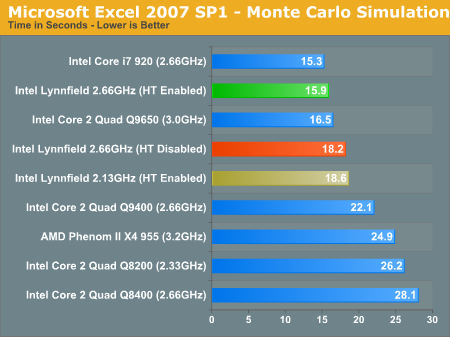
In highly threaded workloads the HT disabled Lynnfield is faster than Penryn at the same price, but still slower than the fastest quad-core Penryn CPUs.
Sorenson Squeeze: FLV Creation
Another video related benchmark, we're using Sorenson Squeeze to convert regular videos into Flash videos for use on websites.
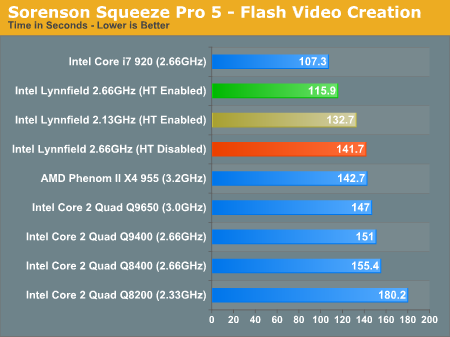
Lynnfield, meet Phenom II, you guys perform alike.
WinRAR - Archive Creation
Our WinRAR test simply takes 300MB of files and compresses them into a single RAR archive using the application's default settings. We're not doing anything exotic here, just looking at the impact of CPU performance on creating an archive:
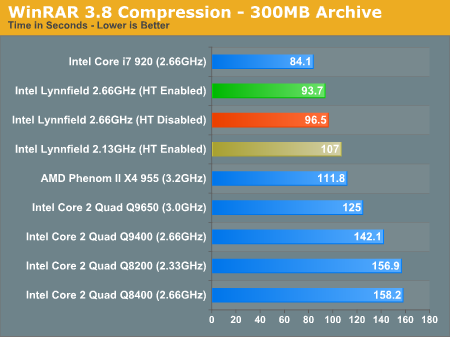
Fallout 3 Game Performance
Bethesda’s latest game uses an updated version of the Gamebryo engine (Oblivion). This benchmark takes place immediately outside Vault 101. The character walks away from the vault through the Springvale ruins. The benchmark is measured manually using FRAPS.

I would caution you against drawing any conclusions based on the gaming performance data here. Fallout 3 isn't heavily threaded and thus would probably exploit the shipping Lynnfield's turbo modes quite well. I would be surprised if Lynnfield didn't perform in the top three once it ships.
FarCry 2 Multithreaded Game Performance
FarCry 2 ships with the most impressive benchmark tool we’ve ever seen in a PC game. Part of this is due to the fact that Ubisoft actually tapped a number of hardware sites (AnandTech included) from around the world to aid in the planning for the benchmark.
For our purposes we ran the CPU benchmark included in the latest patch:
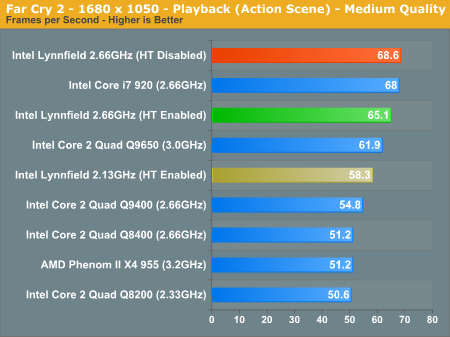
Even without a fully functional turbo mode, Lynnfield does quite well under Far Cry 2.
Crysis Warhead

Power Consumption
I had to overvolt the sample to reach 2.66GHz and I didn't want to compare power of an overclocked CPU to other standard CPUs, so the table below uses the Lynnfield 2.13GHz chip with HT enabled. I also noticed some odd power readings which may be due to the early nature of the platform I was testing so I posted a range of power consumption values for the load.
| Processor | Idle Power | Load Power (x264 1st pass) |
| Intel Lynnfield 2.13GHz | 94.0W | 160W - 173W |
| Intel Core 2 Quad Q8400 (2.66GHz) | 126.3W | 170.9W |
In my limited amount of time with the test setups I didn't have any other lower clocked quad-core chips to compare to but these early results look promising. The idle power in particular is most impressive.
Thanks to Nehalem's ability to completely power down idle cores the Lynnfield sample delivers the lowest idle power of any quad-core CPU I've ever tested. I didn't have time to investigate it here but I suspect that in scenarios where only two cores are busy, Lynnfield will offer significant power savings compared to all older (non-Nehalem) quad-core CPUs.
Final Words
It really took me until I reached the very end of writing this article to understand Lynnfield and where it fits into Intel's lineup, but I think I finally get it.
The $284 Lynnfield 2.80GHz chip should be very powerful. If I'm guessing right, it'll be faster than any dual core Core 2 Duo in applications that spawn one or two CPU intensive threads, while being faster than a Core i7-920 in even heavily threaded applications.
The $196 Lynnfield 2.66GHz processor stops from being absolutely perfect by not having Hyper Threading enabled. While it performs very i7-920-like in many cases, highly threaded workloads favor the rest of the LGA-1156/1366 lineup. That being said, not having HT isn't the end of the world; in many cases it's just as fast as it would be with HT enabled.
What Intel has done with the entry level Lynnfield is piece together a Nehalem that's just good enough to compete with the high end Phenom IIs and give you more bang for your buck than the existing Core 2 Quads, while not being too good as to ruin the point of the midrange Lynnfield.
There's also a lot of flexibility in Intel's strategy. Intel could deliver lower clocked Lynnfields and enable HT to be competitive at lower price points. I suspect that the real strength of Lynnfield is in its turbo modes; they will give it the advantage of delivering maximum performance regardless of how threaded your workload is.
Why would anyone want a LGA-1366 system then? I believe there are three major advantages to the LGA-1366 platform for single-socket desktops:
1) Support for Gulftown. You can only get 6-cores from the LGA-1366 platform in 1H 2010, Intel currently doesn't have any 6-core LGA-1156 parts planned.
2) More overclockable CPUs. The best yielding Nehalems (and highest clocked Nehalems) will be LGA-1366 processors. I wouldn't expect any 1GHz+ overclocks from LGA-1156 CPUs.
3) More bandwidth to PCIe slots. I don't see this as a huge advantage today, but there may come a time when having as much bandwidth to your GPUs as possible is important. I'm thinking general purpose GPU computing, DX11, OpenCL sort of stuff. But we're not there yet.
Ultimately I'm going to stick with what I first said on the whole LGA-1156 vs. LGA-1366 topic last November:
"The breakdown seems pretty simple: if you’re the type of person who bought the Q6600/Q9300, then Lynnfield may be the Nehalem for you. If you spent a bit more on your CPU or are more of an enthusiast overclocker, the current Core i7 seems like the path Intel wants you to take."
Lynnfield, today, looks very good. Enable all of its turbo modes and I believe Intel has another winner on its hands. When Nehalem first launched I complained that the move to a smaller L2 cache kept it from significantly outperforming Penryn in some applications and games. With Lynnfield's turbo modes I believe my complaints will be addressed; need better performance in games? Turbo mode solves that. In many ways, Lynnfield could end up being even more significant than Core i7 ever was.
Penryn was always good, Bloomfield was nice to talk about but Lynnfield may end up being the one you marry.







